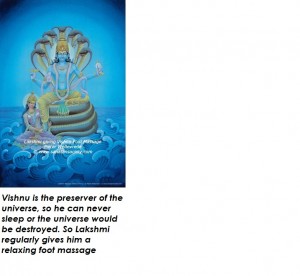Ode to human body – Ayurvedic massage
Man’s strongest desire is to live a healthy, happy, and inspired life. Of these three, health is primary because without it one cannot feel happy or inspired. Food provides us with the proper nutrients, exercise and massage supply the proper circulation. It also helps our bodies grow and renew.
In India massages are given from the time of birth. Babies are regularly massaged with oil, even when they cry. A mother knows that massage will enhance circulation in her infant, who, although continually moving, is unable to perform exercises of any kind. Children are massaged regularly each day until the age of three. Then the routine changes and massage is given once or twice a week, until the child reaches six years of age. At this point, the child is old enough to give and exchange massages with others.
In India, temple sculptures, calendars, and illustrated spiritual books often depict Vishnu, the lord of preservation, reclining on a serpent and receiving a foot massage from his consort Lakshmi. This image suggests that massage is a favorite pastime even of Lord Vishnu.
Ceremonial massages are also practiced in India. Massage before marriage is given for forty days. For the groom, the massage can provide an increase in virility and psychic strength. Because the massage is done with natural herbs and oils, it makes the bride more fragrant and beautiful.
Another traditionally compulsory massage is the one given daily to the new mother during the forty days following birth. Traditionally this is the time for a woman’s complete body purification, after which she can return to performing her daily worship or household chores.
The most popular massage brought from India here Abhyanga which is very often paired with Shirodhara.
Abhyanga- in Sanskrit, the language of the Vedas, abhy means “to rub” and anga refers to the limbs – although we prefer the more poetic translation, “touched by loving hands.” Abhyanga is, therefore, the classic full-body massage of Ayurveda. Warmed oils are selected to bring the subtle energies of the body into balance and applied thoroughly to the skin over the entire body in a series of classic repetitive strokes.
Shirodhara (shiro means head, and dhara means threadlike steam) is the application of a thin stream of oil on the third eye. The marma point is located in the middle of the forehead and is known as sthapani, meaning “what gives support or holds firm”. It is associated with the sixth chakra, prana, mind, senses, and the pituitary. The purpose of the treatment is to center the mind and body, to increase relaxation and inner peace, and to settle vata disorders such as anxiety and insomnia.
In Ayurvada massage is oil. If the body is rubbed dry, the friction created generates heat and pain, which aggravates the element of vata (wind).
Massage oils are a nutrient for the skin and strengthen the nerve fibers that are connected to the hair follicles. The small amount of massage oils remaining on the skin afterwards, and after the shower or bath that follows, provides resistance to environmental temperatures and pressures. Application of massage oils to the navel before going to sleep cures dryness of the whole body. When massage oils are applied at the junction of spine and skull, they calm the entire nervous system, strengthen memory and improve the eyesight.
Consider Ayurvedic massage as a gift for bride and groom, new mom, and everyone who needs tender loving care. Don’t forget yourself!

